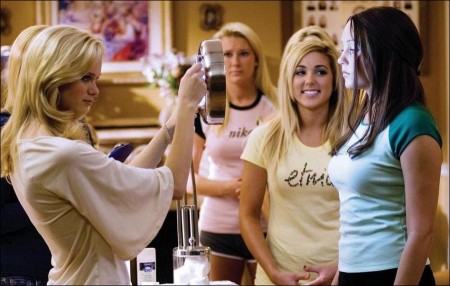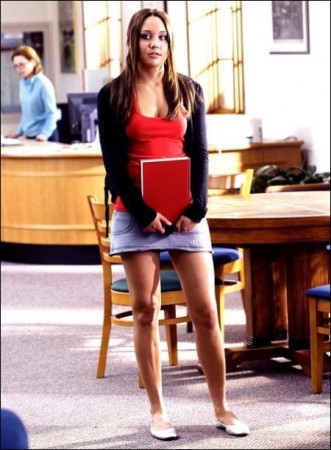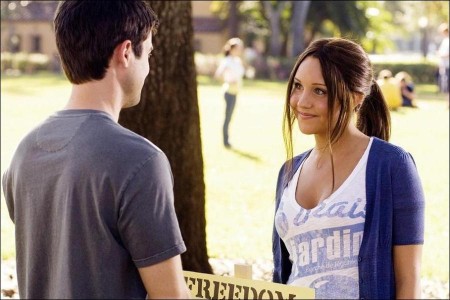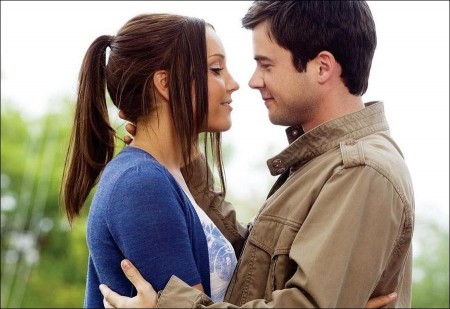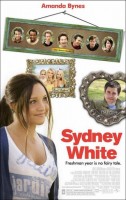Tagline: Freshman year is no fairytale.
In a college comedy that puts a modern-day twist on an age-old story, Sydney White tells the tale of a tomboy freshman who ditches her conniving sorority sisters and finds a new home with a group of very dorky outcasts. Fed up with the way they’ve all been treated, she’s off to war against the reigning campus royalty.
Gorgeous freshman Sydney White (Amanda Bynes) has come to Southern Atlantic University to pledge her late mom’s once-dignified sorority. But while surviving the pledging process wrought by evil campus witch Rachel (Sara Paxton), Syd finds out this version of sisterhood isn’t remotely what it’s cracked up to be.
Banished to a condemned house on Greek Row, Syd finds her rightful place with a band of seven very socially challenged guys. With the help of one lovestruck frat boy named Tyler (Matt Long), she and the doofs campaign to take over student government. Fighting for the rights of misfits big and small, Syd organizes her gang to revolutionize the system, once and for all.
In a biting new comic film for the nerd in us all, Amanda Bynes brings her trademark style of comedy to the story of a plumber’s daughter who builds an army of dorks done wrong: Sydney White.
A Modern Fairy Tale
The story of Sydney White’s creation begins with an unusual player: a young man in graduate school. Screenwriter Chad Gomez Creasey came up with the fractured fairytale concept and wrote the script during his time studying with the Peter Stark Producing Program at the University of Southern California School of Cinema-Television.
Killing time at a coffee shop before class, he was inspired to pen a story that brought a unique twist to seven of the most misunderstood characters in popular literary culture. Gomez Creasey recalls of the heroine and her crew that inspired his story: “I thought of the ‘Snow White’ fairy tale, because she’s such a great character, but then I thought the dwarfs were seven characters ripe to be utilized in a way we haven’t seen.”
This thesis project from the aspiring screenwriter became the tale of a plumber’s daughter named Sydney who had lost her mother at a young age. When it is time for her to start a new life at college, she believes that the best way to connect with her mother is to pledge her mom’s sorority, Kappa Phi Nu. At Southern Atlantic University, she discovers she has to give up a big part of who she is to become a member of the in crowd.
Sydney makes a choice to abandon life in the sorority, leaving her at the mercy of overflow housing—with seven dorky guys. Buoyed by her time with them, Sydney is ready to start a war against the reigning class…with herself at the charge. Gomez Creasey found the comedy in focusing his story not just on Sydney’s struggles, but also on her band of outcasts. He knew there were seven men whose backgrounds in the classic story collected by the Brothers Grimm (in which the heroine’s original name was Snowdrop) could be updated, expanded and explored.
He recalls, “I was that goober dork who lived in graduate school housing, which happened to flank Greek Row at USC. When I would walk to classes every day, I would pass by these huge and beautiful fraternity and sorority houses—inevitably to walk back Thursday night to pass by the giant, raging keggers.”
Creasey ran the concept by his fellow classmate and girlfriend (now co-producer and wife), Dara Resnik Creasey, who loved the idea of a tomboy girl-next-door who comes to a Greek-ruled campus and shakes things up. Gomez Creasey finished the script and gave it to his producing partner to begin shopping about town. After graduation, Resnik Creasey went to work on a comedy-drama starring Hilary Duff, A Cinderella Story. During her time on the set, she would fortuitously meet and develop a working relationship with producer Clifford Werber.
Recalls Resnik Creasey, “One day, Cliff came out of his office and said, ‘I have a great idea for a sequel to A Cinderella Story. It’s called Snow White and the Seven Dorks, and it’s the ‘Snow White’ story set in college.’ So I brought Chad’s script to work, put it on his desk and said, ‘All right, I’ve got it right here.’ He read it, and we sold it one month later.”
Werber brought the project to Morgan Creek Productions, where CEO James G. Robinson and fellow producer David Robinson responded to the fresh take on the centuries-old fairy tale. James Robinson felt the script’s comedic exploration of the themes of “romance, acceptance and rejection” would appeal to a young, new audience.
As the Morgan Creek team and producer Werber explored who could best helm the project, they would turn to up-and-coming director Joe Nussbaum. The filmmaker, who had received fan and critical acclaim for the 1999 Deauville Festival award-winning short he created several years after his work at USC, George Lucas in Love, had spent the past decade making a name in the feature-comedy world. His film about a grown-up nerd made him a natural choice to direct Sydney White.
With the 2004 teen comedy Sleepover and 2006’s best-selling DVD original entry in the American Pie franchise, American Pie Presents: The Naked Mile, also on his résumé, the producers felt they had their man. Commends James Robinson, “Joe just gets it; we knew he was the right guy for this movie. He is the director you want for a young comedy.”
Of his interest in tackling the project, Nussbaum comments, “I’ve really only worked with young casts. The first movie I did was set in junior high, and the second movie was about high schoolers visiting college; now this movie is set in college.” He laughs, “I’m slowly working my way up.”
In Gomez Creasey’s script, Nussbaum saw a world of comic potential. Of the campus universe where the war between the ruling and oppressed strata begins, he summarizes, “It’s small enough that the minority of Greek students controls many of the student activities.” That sense of a time for a growing rebellion appealed to the comic in Nussbaum.
The director liked the idea that there was another world on campus that a certain section refused to acknowledge, ignored by the Greeks but embraced by Sydney. “There is an a cappella group, a band, Pacific Islanders Association, Jewish Student Union, ROTC—but they’re so overshadowed by the Greeks that you get the idea it’s all Greek.”
He knew he could cast a scrappy group where “the dorks reach out to all these other groups and that becomes their power base.” Not only would Nussbaum come aboard as director, he would contribute to the development of characters as the production decided to move the story from California to Florida. Resnik Creasey commends, “We credit Joe for the personalities of the dorks. He helped us define each one of them and made them very specific archetypes. I think everyone’s going to find a dork that they can relate to.”
Nussbaum agreed with the Creaseys that audiences would respond to the dorks just as much as they did Sydney. He reflects, “I think if it was some other fairy tale where it was just about a girl at college, a prince and a queen, it might not have been as interesting. The presence of seven dorky guys—with all their quirks and all their nerdiness—that really lured me because those are my favorite types of characters.”
Shooting script, producers and director in place, the production would turn to the seasoned actor who all agreed had to be their Sydney White. And that was a young woman with a big résumé: Amanda Bynes.
Mirror, Mirror: Casting the Film
For the title character, the filmmakers knew they would have to find an actress who was believable as the adorable girl next door, and who would bond immediately with the misbegotten college kids who lived in the Vortex.
Director Nussbaum read Sydney as a young woman who has “built up this sorority to really mean something. She believes her sisters will be her friends for life if she can fit in. If so, Sydney can connect with her mom. But when she gets there, she sees that it’s so different from what her mom implied it was like—it’s catty, petty and shallow, and run by this girl who is very misguided.”
Upon her first read, Bynes “loved the comedy aspect of the story.” Too, she responded to “the fact that I befriend these dorks and that my character is dorky. I related to the character, because in real life I am very much that way.”
“Amanda has awesome comic timing,” the director relates. “She uses different looks and body language to make sure a scene is funny. She knows how to play a comedic scene—when to give the right pauses and where the laugh is and where it isn’t.”
Agrees producer James Robinson: “Amanda was our first-draft pick, because she is, in fact, that person. If you watch how she plays this character, she just is Sydney.”
As the banned Kappa meets up with her rogue troupe of goofy friends, Sydney begins reevaluating her life as a freshman at SAU and decides to organize a campaign in which the dorks take on the establishment and run for student government. The queen bee and self-appointed ruler, Rachel Witchburn, represents that status quo. And Sydney decides that the only way to make things better is to shake up the system for good.
To play the part of the ultimate bitchy sorority girl, Rachel Witchburn, the production team cast 19-year-old actor Sara Paxton, most recently known for her role as the title character of Spring 2006’s Aquamarine. The director had worked with Paxton in the comedy Sleepover and knew that she was “very subtle, smart and funny.” Since the actor had also played a hateful girl to perfection in that film, Nussbaum knew he had just the right talent to play “a beautiful, blonde, villainous character of 20-21.”
Paxton relished the opportunity to not only work with her director a second time, but take on the role of the delightfully evil sorority girl, whom she found to be “ridiculous with all her antics—making the sorority girls do this and that and judging them.” Best of all for Paxton was the fact that Rachel “gets hers in the end.”
When it came time to choose his dorks, Nussbaum looked for actors who could play socially arrested, developmentally challenged guys that were key to the comedy beats of Gomez Creasey’s screenplay. He admits, however, he was open to interpretation for the roles. “When someone walked in with a unique voice or a unique persona, we could actually tailor a dork to them. That’s what happened with Jeremy Howard, who plays Terrance. He was so funny and quirky and interesting that I started working with Chad on getting a character for Terrance that would be perfect for him.”
Howard, recently seen in last summer’s comedy about another band of losers who get together to challenge the system, Accepted, liked knowing his dork was “a genius when it comes to mathematics, chemical equations and algorithms. But when it comes to life, street smarts and talking to people, he just doesn’t have a clue.”
For the role of the hypochondriac Lenny, actor Jack Carpenter was selected to play the “sneezy” dork. When he came to read for the part, Nussbaum felt “he was just right on the money.” He and the producers believed that Carpenter, with his sheepish sweetness, was the right choice to introduce Sydney to the dorks and take her in when she was in need.
Carpenter particularly liked the physical comedy the part afforded him. For example, in the scene in which he meets Syd, after her sorority sisters literally pile drive past him in a mad dash, he “leaps in a bush, drops my medication on the ground—foot cream and antihistamine—and sneezes, attracting her attention.” Thus, a lifelong friendship is born.
Gomez Creasey designed the characters to be brought out of their shell by the effervescent Sydney. He notes, “Sydney sees that these guys embrace each other, but have absolutely refused to embrace the world beyond the Vortex. She’s going to be the one to get them out of their hole and bring them onto the campus to see that there are other characters out there like them.”
Sydney’s hopeful suitor (and Rachel’s ex) was written as Tyler Prince, a young man who comes from the same background as Rachel. Tyler and Rachel have known one another since middle school, and their parents are funding the Witchburn-Prince Greek Life Center—the same student union with which Rachel is hell-bent on replacing the Vortex.
For the role of the disillusioned fraternity president, the team approached young actor Matt Long, best known for his role in the critically acclaimed WB series Jack & Bobby. Bynes responded happily to Long as her “prince charming.” She loved the fact that “Tyler likes Sydney for who she is, because she’s not like all the other girls. Syd’s about being who you are and fighting for what you believe in; that’s why he falls for my character.”
Long relished shooting a film versus the grueling schedule of his television days, when he shot seven pages of script a day. Of the difference, he notes, “The first two weeks of shooting Jack & Bobby meant 16-hour days on a soundstage; we were filming scenes left and right. And we’ve been on location for Sydney White. It’s just gone really smoothly.”
Dork Vans and Vortexes: Lensing Sydney
The bulk of Sydney White was filmed in the Orlando, Florida, metropolitan area, at the private Rollins College in Winter Park, Florida. Interiors for the film’s Kappa sorority house, where Sydney goes through hazing hell, and the Beta fraternity house, where Tyler lives and reigns, were shot at the University of Central Florida.
To capture the exteriors of the fraternities and sororities along Greek Row, as well as the dilapidated Vortex in which Syd and the dorks reside, the production found a row of homes in Orlando away from the campus that were ideal for DP Mark Irwin to capture on film.
According to Nussbaum, “Greek Row was actually shot on a residential street that had a row of four great, big houses. They had huge columns, and they were close to the street. We went by and said, ‘All this needs is Greek letters, and this street is Greek Row!’ Luckily, we negotiated with homeowners, and they all went for it. And the empty lot at the very end of that street was the perfect place to build our Vortex.”
Pivotal to the story is the point at which, according to Bynes, her character moves into “the Vortex where all the dorks live. As Sydney, I need a place to stay after I am kicked out of my sorority. I become friends with all the dorks, and it becomes another ‘Snow White’ element to the film.”
The crew wanted to create the Vortex as a symbol for all things disenfranchised, misbegotten college kids would have to deal with in sub-par living quarters. The design was intended to be the antithesis of the glamorous sorority houses and steeped-intradition fraternity buildings. Production designer Mark Garner created a shamble of a building that was so in need of repair it should be condemned. The electricity needed to constantly fail, requiring any nearby dork to put out faulty wiring with a fire extinguisher, and the water should constantly burst through the pipes. Fortunately, they found a plumber in their newest roommate, Sydney White.
Of its inspiration, screenwriter Gomez Creasey says, “The Vortex is actually based on my best friend’s basement. As kids, we called it the Vortex, because it literally has this tendency to suck you in and never let you go; that’s where we found ourselves hanging out every day of every summer.”
For the ramshackle home in which the dorks played and schemed, the production built a two-story house on a vacant lot. The director, who also lived with a number of awkward coeds during college, was embracing his inner dork in the creation of the home.
Relates Nussbaum, “It’s a cognate to the cottage in the woods that the seven dwarfs live in, a ridiculous environment for the seven guys. It’s an eyesore—a rundown building that doesn’t belong on Greek Row—and something that Rachel wants to get rid of. Sydney goes in, as the daughter of a plumber, and immediately starts making patchwork repairs to keep it going.
“At the same time, we didn’t want it to just be a decrepit shack,” he adds. “We wanted it to have a little nod, architecturally, to the cottages in the woods that are in all of these great fairy tales, like ‘Little Red Riding Hood’ and ‘Hansel and Gretel.’ The art department and Mark Garner did an incredible job of creating this edifice that immediately brings up fairy tales, but also is completely falling apart.”
To add just the right touches to the dorks’ inner sanctum, the production put an authentic carbonite Han Solo, a life-sized Greedo and Darth Vader in key places in the Vortex. Every dork’s dream. And what better way for the cast to travel to their new haven on the converted suburban Greek Row? Dropping the actors on set was the aptly named “Dork Van,” which chauffeured the company back and forth throughout production.
****
Production wrapped, the cast and filmmakers consider the comedy that they created, and the heart of the picture itself. Reluctant leader of the dorks, Terrance himself (Jeremy Howard), offers why he enjoyed being a part of the latest Amanda Bynes’ comedy: “These guys are very reclusive, and making people uncomfortable and awkward is their task in life. Sydney builds the confidence of the dorks. She takes them out in the world to meet people, putting them in situations where they can expand friendships. They grow fond of her, and they just want to follow along with what she does.”
Director Nussbaum offers his hope for the film: “I think it’s going to be a lot of fun for the audience, especially to find the nods to Snow White in Sydney White. There are tons that are very overt, but there’s actually a couple that are a bit subtle.”
Producer James G. Robinson concludes of this latest take on the fairy tale that will be passed down for generations to come: “Young women will get the joke; older women will get the joke. And young guys? They’ll like looking at lots of pretty girls.”
Production notes provided by Universal Pictures.
Sydney White
Starring: Amanda Bynes, Matt Long, Sara Paxton, John Schneider, Jack Carpenter, Crystal Hunt, Jeremy Howard, Samm Levine, Danny Strong, David Skyler
Directed by: Joe Nussbaum
Screenplay by: Chad Creasey
Release: September 21, 2007
MPAA Rating: PG-13 for some language, sexual humor and partying.
Studio: Universal Pictures
Box Office Totals
Domestic: $11,892,415 (87.3%)
Foreign: $1,726,468 (12.7%)
Total: $13,618,883 (Worldwide)
